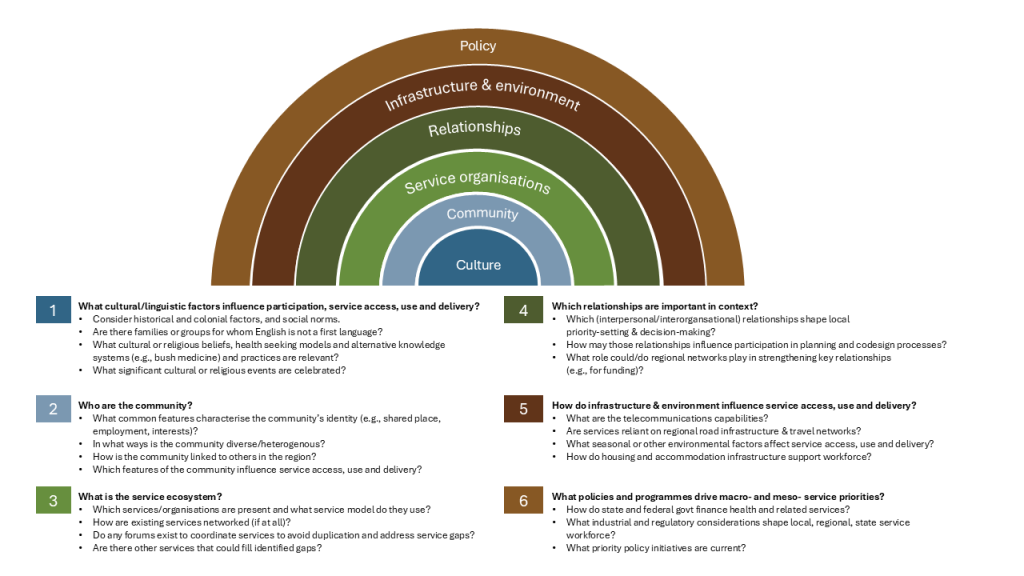Step 2. Understanding the context
Gathering information and accessing existing data
This step of the place-based health planning process aims to gain an understanding of the place by gathering information, exploring available data and mapping existing services available to the community. Key areas to explore include culture, the community, service organisations, relationships, infrastructure and environment, and the policy context (Figure 4.2.1).

Engaging with key stakeholders will confirm and explain community dynamics, historical incidents and other events that may impact on the planning work. This requires effective community engagement in the preparatory stages and throughout the implementation stages too. Effective community engagement facilitates iterative, time-sensitive, deep listening approaches to understand these varied perspectives and relational dynamics and understand how they work in context.
Local data about population, economy, health status, service utilisation and health workforce can be accessed from a variety of sources. Data may be accessed through the public domain or through data request procedures.

Appendix 4 – Data Sources: lists possible data sources with a focus on regional and community areas.
Conduct service mapping
Compile a directory or table of services, including local and visiting services that provide health or health-related services. Depending on the local environment, other services can also be listed. For example, in remote Aboriginal and Torres Strait Island communities, including Kowanyama, Community Enterprise Queensland is a not-for-profit organisation that is engaged to provide essential goods to communities, such as through a supermarket. This group also provides health promotion activities.
Desktop searches of regional, state and national organisations, as well as national directories (such as My Community Directory), are a good place to start.
Local organisations, such as the local council, often have a service directory that may be used as a starting point.
Service mapping can be informed by community engagement activities as the work progresses.
Areas of interest include the purpose of the service, the mode and frequency of service delivery, type and quantity of workforce, funding sources and accessibility for community members.
Depending on the purpose of the work, service mapping may include health, social, education and welfare sector services as well as community-based support groups and digital services.
Service mapping activities generate useful outputs that demonstrate reciprocity (value for giving back to the community). Outputs include up-to-date service directories which can include information about referral pathways and costs, community calendars containing visits by outreach services and funding maps that help communities assess how and if funds are being spent as intended to benefit their community.

Appendix 5 – Services Overview: provides an example overview of health and health related services in the Hughenden community at the time of the project.

Conduct environmental scans
Desktop searches and community engagement activities will provide information on structural factors that may influence service access (geographic accessibility, affordability, timeliness, acceptability, availability, appropriateness), use and delivery.
Information needs include policy direction (scan relevant health strategies, plans and policies), infrastructural factors such as accommodation for the workforce and geographic factors such as seasonal weather.
Other relevant data or information may be found in policies and program rules that impact the local community.
Explore local infrastructure and environmental factors. Remoteness, access, transport options and availability of local accommodation can impact service delivery, especially if there are fly-in/fly-out or drive-in/drive-out health professionals visiting community to provide services (Figure 4.2.2).
Environmental factors such as climate, fluoridation of water supplies, availability of fresh food, and accessible free spaces and options for physical activity can impact the health of the local community.
Explore community dynamics and other impacting factors
Consult with the local connector, reference group and key stakeholders to understand relationship dynamics and events that may influence participation and engagement (see step 1).
Engage with stakeholders to understand contextual aspects affecting health and services.
Consult with key stakeholders and local experts to understand the history and changes in local health status and service delivery (see step 1 and step 3).

Through the project, data and information were collated to produce a ‘health and services report’ for each community. These were ‘living’ documents and updated throughout the project timeframe. The reports for each community are available on the project website at:

Listen to our Hughenden Local Connector talk about sharing knowledge and learning:

A key component of effective planning involves considering all related factors that influence health and health service delivery in the community.

